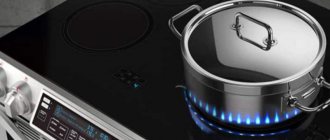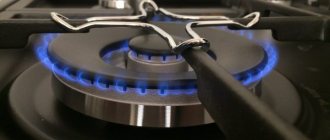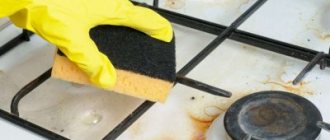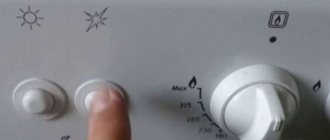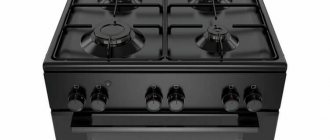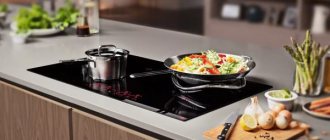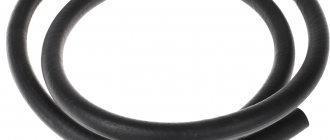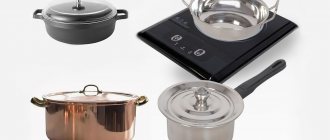These household appliances have gained great popularity - the tariffs are fair, and if you install a gas meter, the bills will be minimal. Massive gasification was carried out everywhere back in the days of the USSR, which is why most Russians have just such products installed. Despite its widespread use, users are still often interested in the design of a gas stove. Let's consider its main functional units and the principle of their interaction.
Slab design
A modern gas stove combines several systems, each of which is responsible for the normal functioning of controlled parts and devices.
- The basic one is a gas system. It consists of burners, burners, pipelines and shut-off valves.
- Electric - it is responsible for lighting, electric ignition, and in some models ensures the operation of the grill installation.
- The supporting structure is the body of the product, which is made of stainless steel sheet and coated with enamel.
Each gas stove has a standard set of parts. Different models may have their own nuances and unique design, but the composition of the main components has not changed. The schematic diagram of a gas stove is shown in the photo below.
A gas stove is
@t10p.ru
A gas stove is one of the types of household appliances, presented in the form of a kitchen stove, which uses flammable gas as fuel. In most cases, it is recommended to use natural gas from the city gas network.
The flame regulation function is implemented by changing the volumetric velocity of the gas that enters the burner. It is worth noting that gas stoves are in great demand among all categories of consumers, as they act as an indispensable assistant in cooking.
General principle of operation of the equipment
Regardless of the type of model, its cost and arrangement of elements, all equipment works according to the same scheme. The only exception may be some exotic industrial equipment with combined fuel.
Operating principle of a gas stove:
- Gas is supplied to the burner from the mains or an independent source (cylinder).
- After opening the shut-off valve, fuel flows to the burner.
- The design includes a mixing system, where gas, in contact with air, changes its properties.
- The mixture is taken to the divider, where it is evenly distributed around the perimeter.
- Using auto-ignition or a match, the composition is ignited, and combustion is maintained at a user-specified level.
If the system is debugged and works as the manufacturer intended, then the fuel will burn completely without emitting fumes, and the flame will stably maintain the selected level. The efficiency will remain close to 100%. A faulty system will smoke, periodically go out, or refuse to ignite at all.
Burner products
Many people confuse the burner and the burner, so the burner is located inside the stove under the hob, and on top there are burners with dividers, which can be removed and wiped during wet cleaning (just try not to let water get into the holes of the divider). If you remove the burner, then underneath it in the depths you can see the burner body and the nozzle, from the hole of which the gas enters the socket of the divider, where it mixes with air for stable combustion. Each burner is characterized by a certain power; in everyday life there are the following options:
- minimum flame when the regulator is in the extreme left position;
- medium heat - the regulator is in the middle;
- maximum combustion - the regulator is in the extreme right position, the burner is completely heated, the flame is stable and does not come off the divider, the gas burns completely.
Gas burner diagram
Experts have this concept - the optimal power of a product. It is determined by the most complete combustion of blue fuel and is indicated in the technical characteristics of the gas stove.
When switching to another type of fuel, for example, liquefied gas from cylinders, it is necessary to change the jets, and the entire set. It is better to entrust such work to a professional - he will immediately adjust the pressure and ensure that complete combustion of the fuel occurs.
There are only three types of burners commonly used:
- diffusion;
- kinetic;
- mixed option.
The names come from the combustion feature: in the first version, there is no forced mixing with air - a stream of gas enters the bell of the burner, where it naturally mixes with air. The oven burner is of the first type - air is taken from the inside of the stove. In the second option, suction is carried out due to the energy of gas movement under low pressure, mixing occurs and the combustible mixture is supplied to the burner. In modern models, a third option is used, when half of the air is taken from inside the product, and then in the bell of the burner the mixture is additionally mixed with the outside air of the kitchen.
Types of burners
There are not so many of them:
- kinetic;
- diffusion;
- combined type.
As we can see from the names, they are taken from the characteristics of the combustion that occurs. So, in the first option there is no preliminary mixing of the gas-air mixture, simply a stream of gas enters the burner, where it combines with air and subsequent combustion.
In the second option, the injector sucks in air along with gas, a mixture is formed, and a spark is supplied. In gas stoves, the third option is used, with half of the air taken from inside the body, and the second from the kitchen. And in the oven, the diffusion principle is used, since air is taken from a limited space inside the product. Therefore, the task of the master during the first installation is to correctly configure the oven burner.
The requirements for all gas stoves and ovens are the same:
- Ensure complete combustion of gas.
- Stable combustion in all modes of use.
- Simple and reliable service.
The main parameters are precisely determined by the burners, because the mixture is formed there, and ignition occurs when it exits the perforations of the divider. When cleaning, the housewife must ensure that all openings are clean and ensure the unhindered exit of the gas-air mixture, then the flame will be stable and even.
Electrical system
There should be no questions about classic ignition: light a match, bring it to the burner, and the gas ignites. Modern models are equipped with more advanced systems with a piezo element. The latter is a small module with an outlet to the burner, where when you press a button, a spark appears that ignites the fuel.
The equipment can be equipped with both fully automatic and semi-automatic ignition systems . The latter is installed, as a rule, on budget and mid-budget gas stoves.
- Automatic ignition. Immediately after turning the lever to supply gas, the piezo element on the selected burner is activated and ignition occurs.
- Semi-automatic ignition. When you press the button, a spark passes through all the burners, but only the one where the gas valve was opened lights up.
Both systems depend on electricity and will not work without it. In this case, you will have to use matches or a lighter to ignite.
In addition to electric ignition, a gas furnace also has other elements that run on electricity. Very often, developers install an electric grill inside the oven to provide a golden brown crust to the dish. Also, every modern model has an internal lighting system. It is turned on by pressing a special key on the control panel located on the front side of the product. A working oven is illuminated from the inside for visual control of the quality of cooking.
Electrical control and monitoring system
The cheapest stoves do not have electronic control - the entire process is controlled mechanically . In more expensive models, an electrical system is connected to enable the electric ignition and lighting , as well as spit control .
The design of electric ignition plates includes candles located on the divider body. They instantly fire when turned on, that is, at the moment the gas escapes
Some users are so accustomed to the auto-ignition system that they get lost when the power goes out and don’t know how to turn on the gas. This is done simply: the control knob must be placed in the working position, and then a lighted match must be quickly brought to the divider.
The backlight function works differently: in some ovens it turns on by pressing a button, in others it turns on automatically, every time the oven is turned on.
Gas control, which is operated by a thermocouple, is very useful.
The main purpose of the thermocouple is to shut off the gas supply if the burner flame goes out for any reason. Operating principle: the fire disappears, the temperature drops sharply, the gas is automatically shut off
The most expensive models are equipped with electronics, which facilitates both the cooking process and equipment maintenance.
Using a panel with buttons and a display, you can control all processes, which may include the following:
- timer;
- delayed start;
- steam oven cleaning;
- several cooking modes;
- light and acoustic alarm;
- electronic temperature control;
- rapid cooling system, etc.
If the stove is inexpensive, but equipped with electronics, you should ask yourself the question: how often will you have to contact the service center? Because, according to statistics, electronic equipment breaks down much more often than conventional equipment.
Gas control system
Control over combustion stability is carried out using a thermocouple - it shuts off the gas supply if for some reason the flame goes out. This system is called “gas control”. This control works regardless of the presence of electricity - it all depends on the temperature: when there is no electricity, the thermocouple turns off the gas.
When the gas burner is operating, the thermocouple heats up, the solenoid valve releases the damper, holding it in the open position. When the flame goes out due to unforeseen circumstances, for example: water boiled in the kettle and splashed onto the burner. The quickly cooling thermocouple has no effect on the valve solenoid, the flap closes and the gas supply stops.
Gas control
The entire system, called gas control, is based on three pillars: thermocouple, sensor, solenoid valve. If the thermocouple gives a stable signal, the valve remains open and the stove operates. If the flame goes out, the thermocouple is not charged, the valve closes and shuts off the supply of blue fuel.
This principle applies to both cheap and top-end gas stoves. The only difference is how sensitively and quickly the system reacts to the gas supply. For example, in Darina gas stoves, gas control is activated 15 seconds after switching on, regardless of what is switched on: the hob or the oven. By the way, the DARINA 1D1 GM241 022 W model demonstrates good characteristics. Four gas burners on an enamel table, a gas grill will help you cook anything, gas control and electric ignition of all burners on the stove work for safety.
It is better to choose equipment where gas control is provided on the burners of the hob and oven. Hansa offers full capabilities with the Hansa FCGX51029 model. In addition, the device is quite attractive (after all, it’s not for nothing that the specialists of the Code design bureau were fussing over it), functional, works on catalytic cleaning and provides a good usable volume of 58 liters.
If you are looking for a retro style, the Italians offer gas stoves with full gas control. A very attractive choice would be the Zanussi ZCG 562 GN model. The classic design is emphasized by anthracite color and gold fittings. In addition, compared to the Hansa, there is a larger usable volume of 61 liters.
Gas stove oven
The oven of a gas stove is also equipped with burners, only their size is much larger. Depending on the number and location of heating elements, there are several types of ovens.
- With a bottom burner, without a fan. A budget option. The heating intensity depends on the gas supply and the location of the baking tray with the dish.
- An oven with a bottom burner and a fan is a more advanced option. The fan ensures uniform heating throughout the entire volume.
- The most modern ovens are equipped with several burners: they can be not only at the bottom, but also on the side or even at the top.
To ensure tightness, the oven has a thermal insulation layer. The door is equipped with laminated glass, which allows you to retain heat inside without getting too hot outside.
Hole for igniting the flame in the oven
The heating mode is selected using the control knob. Ignition can be manual or automatic. For the first option, there is a hole at the very bottom in the middle to which a match or a special lighter is placed. There is a red button on the control panel - you must press it to open the gas supply. When the burner lights up, you need to hold the button for a few seconds to heat up the thermocouple that controls the solenoid valve. If you immediately remove your finger from the button, the flame will go out; all actions must be started all over again.
Modern models are equipped with electric ignition, the effect of which is similar to the previously described options for switching on
Wash removable and non-removable handles
Depending on the configuration of your stove, the handles may come off or be welded on. If you don't know what type of stove you have, grab the handle and pull it towards you a little. The removable mechanism gives in easily, so if movement occurs, keep pulling on the handle, it is removable. If the product does not give in and cannot be removed, it means it is welded. Look to see if there are any bolts or locking nuts on the back, sometimes all you need to do to remove an item is unscrew a couple of screws.
Removable handles
The easiest option for cleaning is the removable handle. You can soak it for a few minutes in plain water, rub it with a sponge, after which dirt and fresh grease will come off without effort. To remove more serious stains, fill a basin with hot water and add about half a glass of grated laundry soap. Dissolve the crushed soap well in water and immerse the removed handle in the soap solution, leave the product for at least 10-15 minutes, then walk over the surface with a soft-bristled brush and a foam sponge. If you have never removed the handle before, soak it in the soapy water a little longer until the water cools down, then clean it. Laundry soap cleans plastic, stainless steel, and other metal well, as it destroys most contaminants. After cleaning, wipe the product with a dry towel and return it to its original place.
Wipe dry with a microfiber cloth: it does not leave hairs or small threads behind.
Fixed handles
It is more difficult to clean the non-removable handles on the stove, since washing them is not very convenient: grease and other stains accumulate in hard-to-reach places, where it is difficult to reach with a simple rag. Experienced housewives know about this and recommend using cotton swabs, discs, wet wipes, toothpicks, and pieces of foam sponge when washing. Small objects easily penetrate into cracks and gaps, from where dirt, soot and soot are removed. The wipes can be wrapped around your finger and cleaned. This method takes much more time, however, the cleaning will be very effective.
Oven thermostat
This element is necessary to maintain the set temperature inside the chamber. Depending on the chosen model, there are electronic, electromechanical and mechanical thermostats. For adjustment, a knob that rotates in a circle is most often used. In the case of an electronic system, this may be a touch display with numerical data visualization.
The main element of the thermostat is a dilatometer, which responds to temperature fluctuations inside the chamber. As soon as it rises to a critical level, the linear rod expands, affecting the valve. The latter begins to gradually cut off the gas supply. If the temperature, on the contrary, decreases, then the dilatometer gives the command to increase the volume of fuel supplied for combustion.
Oven thermostat
The parameters critical for cooking dishes are configured by the user himself through local control. If the thermostat fails, the oven will either warm up to maximum values or stop raising the temperature altogether.
Rules for using the stove
All gas stoves have instructions for their operation, but we will remind you of some points that should not be forgotten during the initial installation and further use of household appliances:
- when connecting, you must turn off the electricity in the entire apartment;
- remove mobile phones from the kitchen or turn them off;
- open the window and turn on the exhaust system in winter;
- close the gas supply valve tightly and check it with soap foam for leaks;
- When installing, use only special tools and materials;
- After connecting, check all connections for gas leaks using soap foam.
If even a small bubble appears, the connection should be tightened and checked again. If there is a smell of gas in the kitchen, then you need to check all the connections; when the location of the leak has not been identified on your own, call a technician to diagnose the entire connection system and internal connections. Strict implementation of the necessary safety measures is the key to preventing a fire hazard. Remember that gas tends to explode at the slightest spark.
Tips for replacing gas taps
In apartments or houses, gas communications last for many years. The only thing is that they require periodic inspections and maintenance (painting of pipes). The most vulnerable parts of such structures are gas valves. Of course, they are used several times a day, or even more. It is due to heavy loads that gas valves break. Breakdowns of gas taps made from low-quality raw materials occur especially often. Plastic products break down faster than others.
Not everyone knows when the faucet needs to be replaced. The answer is simple - when you smell an unpleasant aroma characteristic of gas, you need to check where the smell is richest. If the leak is in the gas valve area, then it should be replaced.
Inspect the product, you may notice cracks or other damage on it. Maybe the tap turns tightly or, on the contrary, turns too freely, then we can safely say that the device is out of order. But you cannot replace the locking device yourself. Don’t tempt fate - call a gas service worker.
It will replace your gas tap for free, your only task is to buy the right mechanism that will fit your gas pipes and will last for many years. We described the selection rules above.
Replacing a gas tap is carried out using a special technology and must be performed by a person who has permission to do such work
If there is a need to change the device, do the following:
- First, dial the number of the gas utility and report your problem to the dispatcher.
- Buy a suitable faucet, take into account the diameter of the pipes, thread pitch, and other nuances. Don't choose the cheapest product.
- Prepare documentation for gas specialists. Most likely you will need: a technical passport, gas supply documentation.
- When the employee arrives, he will ask you to light the burner and close the valve that controls the gas supply. This will allow the fuel to come out of the pipe.
- All work on replacing or repairing gas equipment must be carried out in a well-ventilated area.
- The technician will replace the tap and check its operation, and he must also check for gas leaks.
- When the repair of gas communications is completed, the specialist will ask for a technical passport and make a record of the work done.
A natural fuel leak is detected by using soap foam. Foam is applied to the joints and faucet, and then the foam is carefully monitored. If there is a gas leak, bubbles begin to form in this area.
